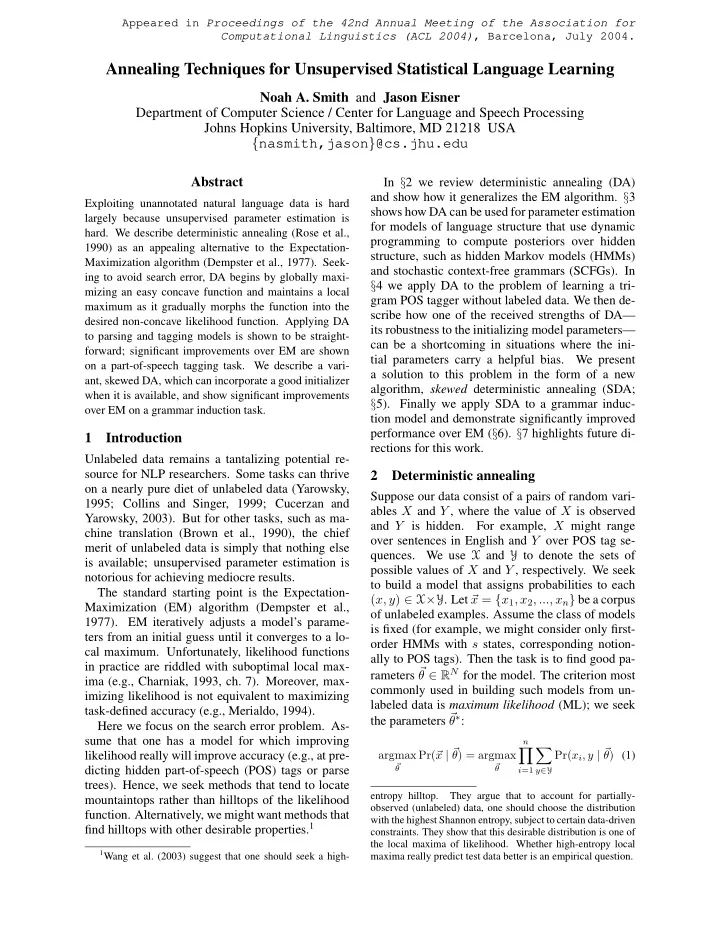

Appeared in Proceedings of the 42nd Annual Meeting of the Association for Computational Linguistics (ACL 2004) , Barcelona, July 2004. Annealing Techniques for Unsupervised Statistical Language Learning Noah A. Smith and Jason Eisner Department of Computer Science / Center for Language and Speech Processing Johns Hopkins University, Baltimore, MD 21218 USA { nasmith,jason } @cs.jhu.edu Abstract In § 2 we review deterministic annealing (DA) and show how it generalizes the EM algorithm. § 3 Exploiting unannotated natural language data is hard shows how DA can be used for parameter estimation largely because unsupervised parameter estimation is for models of language structure that use dynamic hard. We describe deterministic annealing (Rose et al., programming to compute posteriors over hidden 1990) as an appealing alternative to the Expectation- structure, such as hidden Markov models (HMMs) Maximization algorithm (Dempster et al., 1977). Seek- and stochastic context-free grammars (SCFGs). In ing to avoid search error, DA begins by globally maxi- § 4 we apply DA to the problem of learning a tri- mizing an easy concave function and maintains a local gram POS tagger without labeled data. We then de- maximum as it gradually morphs the function into the scribe how one of the received strengths of DA— desired non-concave likelihood function. Applying DA its robustness to the initializing model parameters— to parsing and tagging models is shown to be straight- can be a shortcoming in situations where the ini- forward; significant improvements over EM are shown tial parameters carry a helpful bias. We present on a part-of-speech tagging task. We describe a vari- a solution to this problem in the form of a new ant, skewed DA, which can incorporate a good initializer algorithm, skewed deterministic annealing (SDA; when it is available, and show significant improvements § 5). Finally we apply SDA to a grammar induc- over EM on a grammar induction task. tion model and demonstrate significantly improved performance over EM ( § 6). § 7 highlights future di- 1 Introduction rections for this work. Unlabeled data remains a tantalizing potential re- source for NLP researchers. Some tasks can thrive 2 Deterministic annealing on a nearly pure diet of unlabeled data (Yarowsky, Suppose our data consist of a pairs of random vari- 1995; Collins and Singer, 1999; Cucerzan and ables X and Y , where the value of X is observed Yarowsky, 2003). But for other tasks, such as ma- and Y is hidden. For example, X might range chine translation (Brown et al., 1990), the chief over sentences in English and Y over POS tag se- merit of unlabeled data is simply that nothing else quences. We use X and Y to denote the sets of is available; unsupervised parameter estimation is possible values of X and Y , respectively. We seek notorious for achieving mediocre results. to build a model that assigns probabilities to each The standard starting point is the Expectation- ( x, y ) ∈ X × Y . Let � x = { x 1 , x 2 , ..., x n } be a corpus Maximization (EM) algorithm (Dempster et al., of unlabeled examples. Assume the class of models 1977). EM iteratively adjusts a model’s parame- is fixed (for example, we might consider only first- ters from an initial guess until it converges to a lo- order HMMs with s states, corresponding notion- cal maximum. Unfortunately, likelihood functions ally to POS tags). Then the task is to find good pa- in practice are riddled with suboptimal local max- θ ∈ R N for the model. The criterion most rameters � ima (e.g., Charniak, 1993, ch. 7). Moreover, max- commonly used in building such models from un- imizing likelihood is not equivalent to maximizing labeled data is maximum likelihood (ML); we seek task-defined accuracy (e.g., Merialdo, 1994). the parameters � θ ∗ : Here we focus on the search error problem. As- sume that one has a model for which improving n x | � � � Pr( x i , y | � argmax Pr( � θ ) = argmax θ ) (1) likelihood really will improve accuracy (e.g., at pre- � � dicting hidden part-of-speech (POS) tags or parse θ θ i =1 y ∈ Y trees). Hence, we seek methods that tend to locate entropy hilltop. They argue that to account for partially- mountaintops rather than hilltops of the likelihood observed (unlabeled) data, one should choose the distribution function. Alternatively, we might want methods that with the highest Shannon entropy, subject to certain data-driven find hilltops with other desirable properties. 1 constraints. They show that this desirable distribution is one of the local maxima of likelihood. Whether high-entropy local 1 Wang et al. (2003) suggest that one should seek a high- maxima really predict test data better is an empirical question.
Recommend
More recommend